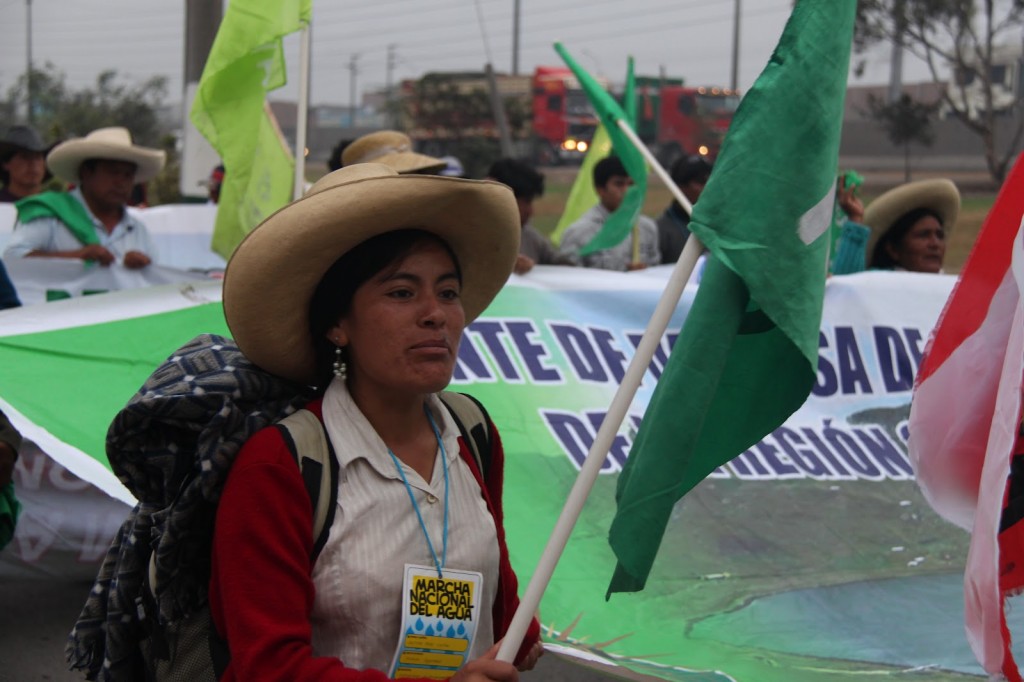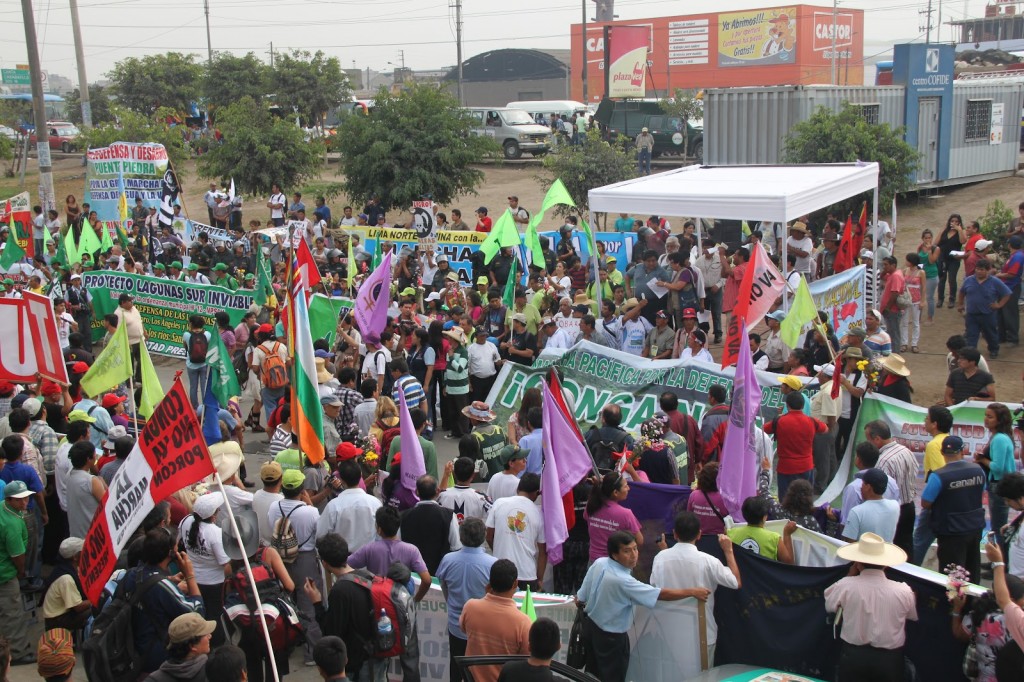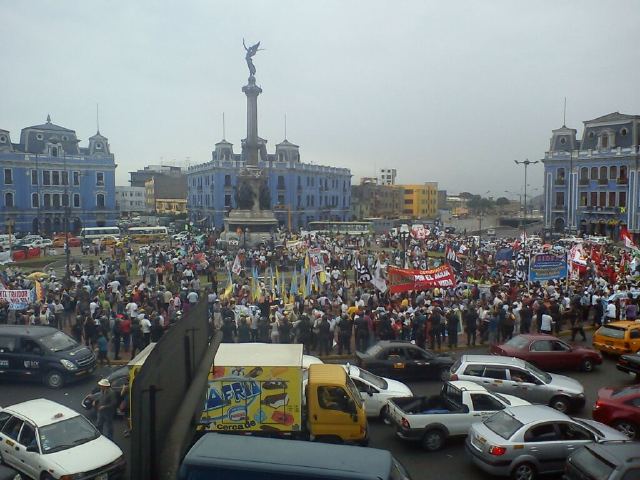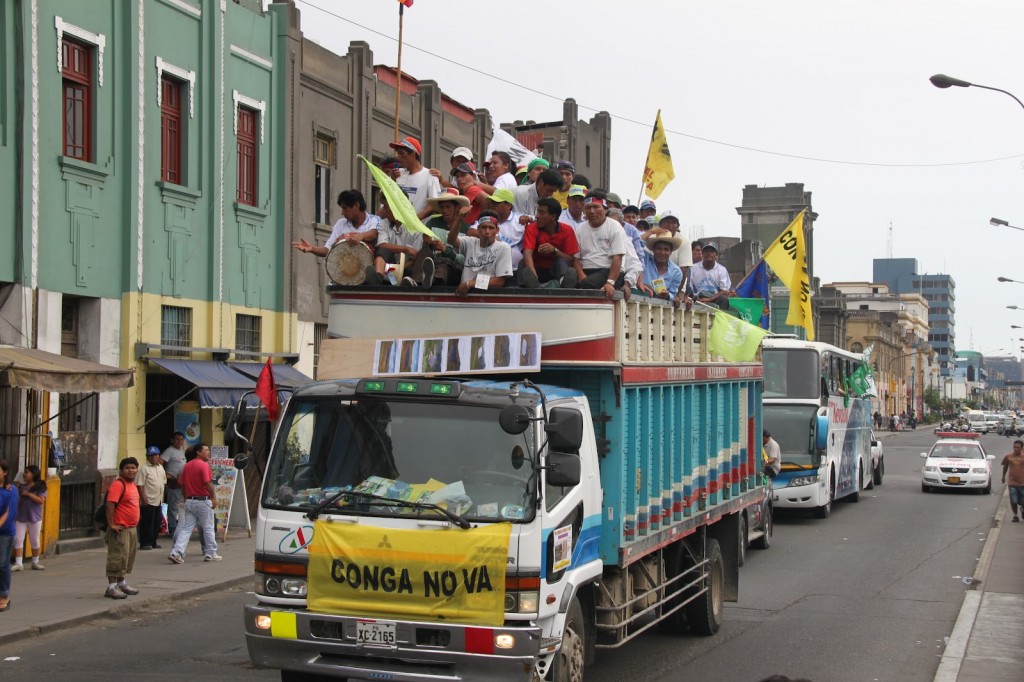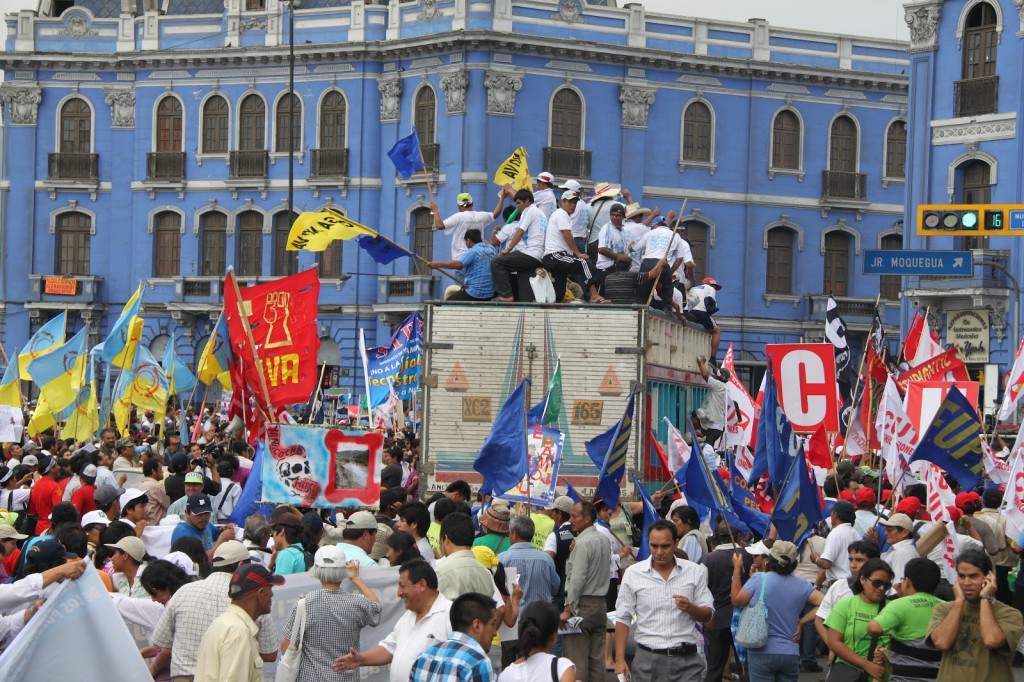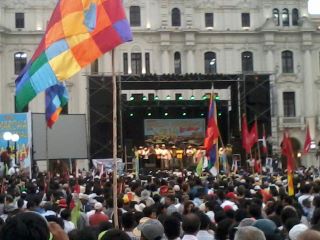[All links lead to Spanish language pages except when otherwise noted]
Finally the water march arrived in Lima [1] [en]. In the previous post [2] [en] we had left them in the city of Huacho, which is approximately two and a half hours from Lima. They left Huacho [3] at dawn on February 9, 2012, and they entered [4] Lima in the morning.
The Observer Group blog posted [5] some photos of the march arriving at Puente Piedra:
Simultaneously, Cajamarca carried out mobilization in support [8] of the marchers in Lima. The Cajamarca Environment Defense Front blog reports [9]:
Los manifestantes que asistieron a la movilización portaban gigantes banderolas y pancartas, a la vez que vestían diversos polos con consignas en contra del proyecto Conga y consignas en defensa del agua, se coreaban consignas como: ¡ Aquí, allá, Conga no va !, ¡ Ollanta traicionero, el agua está primero !, ¡ Agua, plata y cobre, Cajamarca sigue pobre !, ¡ Ni un paso atrás, el pueblo vencerá !, ¡ Siempre de pie, nunca de rodillas !, etc.
The estimations of the amount of people that arrived in Lima as part of the water march varies between 500 [10], 600 [11], 1200 [12], 1500 [13] and 2000 [14]. After focusing on the Plaza Dos de Mayo, the marchers, led by former priest Marco Arana and the Cajamarcan leader Wilfredo Saavedra and accompanied by supporters of Lima, went all through the city center on foot. Then they went to the district of El Augustino, where they had lunch, before meeting at 03:00 pm at the Plaza Bolognesi to leave for the district of Pueblo Libre, where they carried out the Water Forum “Water, Mining and Development in Peru today.”
The Yfrog user, Goomez, posted [15] a photo that illustrates the police presence in the Plaza Dos de Mayo when the people and delegates gathered for the Water March:
The Observer Group report for the day records, among other things, the following [16]:
Después de almorzar y descansar, la gente se dirigió al Foro Hídrico, donde fueron recibidos por pobladores de La Oroya, Cerro de Pasco, Cusco, Puno, Tacna, Chimbote, Piura, Arequipa, Loreto… en un encuentro masivo, que congregó también a ambientalistas, organizaciones de derechos humanos, y personalidades como Hugo Cabieses y José De Echave, ex vice ministros del ambiente del gobierno de Ollanta Humala, el congresista Javier Diez Canseco del Partido Socialista y Peter Koenig, experto del Banco Mundial.
After lunch and resting, people went to the Water Forum, where they were welcomed by residents of La Oroya, Cerro de Pasco, Cuzco, Puno, Tacna, Chimbote, Piura, Arequipa, Loreto … in a mass meeting, that was also attended by environmentalists, human rights organizations, and people like Hugo Cabieses and Jose De Echave, former vice ministers of the environment of the Ollanta Humala government, Congressman Javier Diez Canseco of the Socialist Party and Peter Koenig, World Bank expert.
One incident that quickly jumped out to the media [18] was the police confiscation of a young marcher's banner with the symbol of the hammer and sickle. The youngster stated that it was a banner of the military party, Patria Roja, which is unrelated to the Shining Path terrorist movement. The journalist Raul Weiner called this incident delusional McCarthyism [19] given that communism, whose symbol is the hammer and sickle, has not been banned in Peru.
The following day, February 10, the March returned to focus on the Plaza Dos de Mayo and they went via Avenues Colmena, Wilson, Paseo de Los Héroes Navales, el Parque Universitario y Abancay, to get to Congress, but the tight security prevented them from reaching their destination. Nor were they greeted [20] by President of Congress. However, a committee of Congress came to them and they received [21] two legislative initiatives from the national commission for the Water March. Then they went [22] to the Plaza San Martin where a closing rally [23] was scheduled [24] for the night hours.
The following videos, the first submitted by YouTube user Demoliciontv [25] and the second by vladimirteran [26], capture different moments of the rally in the Plaza San Martín.
In the hours of the morning the National Tribunal of Water Justice was carried out, with objectives including [27]:
Identificar y visibilizar los conflictos hídricos que hay en el país, las demandas y propuesta de los pueblos que luchan por la protección, defensa y gestión justa del agua, y por el derecho a decidir su modelo de desarrollo, a ser previamente consultados y preservar su modos de vida y culturas.
The Court will issue some resolutions that will be delivered to the International Observer Mission of the March and released by the Organising Committee for the National March. The Observer Group, meanwhile, posted [28] its report of the tenth day of the march, with some photos and stories of what happened during the day:
En una interminable serpiente humana de más de 2 kilómetros de longitud (30 cuadras), unas quince mil personas recorrieron el centro de Lima. Salieron de Plaza 2 de Mayo a las 3:30 de la tarde y tras una largo itinerario por las principales avenidas de la capital llegaron a la Plaza San Martín, donde se celebró un mitin multitudinario, como acto de cierre de la Gran Marcha Nacional del Agua.
In an endless human snake over 2 km long (30 blocks), about fifteen thousand people marched through downtown Lima. They left Plaza de Dos Mayo at 3:30 pm and after a long journey through the main avenues of the capital they arrived at the Plaza San Martin, where they held a mass rally, as an act of ending the Great Water March.La entrevista acordada con el ministro del ambiente fue demorada en sucesivas ocasiones, por la reunión de emergencia del Gobierno que, al durar todo el día hasta bien entrada la noche, acabó desplazando el encuentro a la semana que viene.
The agreed interview with the Environment Minister was delayed several times by the emergency government meeting that lasted all day until late at night, so they ended up moving the meeting to next week.
Meanwhile the Cajamarca Environmental Defense Front blog graphically reports [32] about what happened in the Plaza San Martin with some pictures:
Although the Water March is over, the struggle for water resources in the country will continue for some time. Wilfredo Saavedra, President of Cajamarca Defense Coalition indicated [35] that “we are proposing to the government a deadline of the third week of March to declare Conga unviable and review everything that has to do with the mining legislation, water and environment.” Culminating he said, “the people of Peru are being summoned to Cajamarca for the first assembly of the people of Peru.”
But not everyone is in agreement with the attitude of the activists. Ronald Ancajima of the Sustainable Water Management blog discusses several arguments and he thinks [36]:
Por ahora creemos que la marcha por el agua ha servido de alguna manera para sensibilizar en la necesidad de cuidar el agua, pero es necesario estar avisados y sobre todo alertas con nuestros jóvenes que movidos por su ímpetu de cambio pueden acceder de manera fácil a discursos sin propuestas de desarrollo.
Juan Archiof in The innocence of Reason blog, reflects [37] on the usefulness and importance of the marches today:
Toda marcha nacional es la expresión de una fuerza simbólica que ejerce una parte de la ciudadanía, para decirle al conjunto de la misma que hay problemas que involucran y afectan a la gran mayoría de los ciudadanos. Por ello no es casual que una de las consignas que se escuchaba a lo largo de la Marcha Nacional del Agua, a saber: “¡Hay oro! ¡Hay cobre! ¡Y el pueblo sigue pobre!”, generaba mucha empatía entre los transeúntes que no eran indiferentes al paso de la enorme movilización nacional. Madres y padres de familia, jóvenes y hasta niños, curiosos o no, asentían con la cabeza que las consignas lanzadas con ahínco ese día tienen una gran significación en la reproducción de la vida cotidiana.
And Magaly Vera commented [38] on the campaign, discrediting and belittling the information that certain media forms [39] were making towards the Water March:
Alguien por ahi decia que era una marcha que no lograría congregar masas, que la población esta consciente que la mineria es importante en el desarrollo de un país, y hasta intentan meternos un chip en el cerebro pasando un spot y gastando millones en publicidad en señalar que la mineria es más vital que el agua. Esta, es la respuesta de los peruanos: Una imagen habla mas que mil palabras
Someone said there was a march that would fail to gather masses, that the population is aware that mining is important in the development of a country, and to try to get us a chip in the brain by advertising and spending millions on publicity to show that mining is more vital than water. This is the response of Peruvians: A picture speaks a thousand words
You can read more information on the Water March on Facebook [41] and Twitter [42].
Other posts about the topic:
Peru: Preparing for the Great Water March [44] [en]
Peru: Following the Water March [45] [en]
Peru: The Water March approaches Lima [2] [en]
